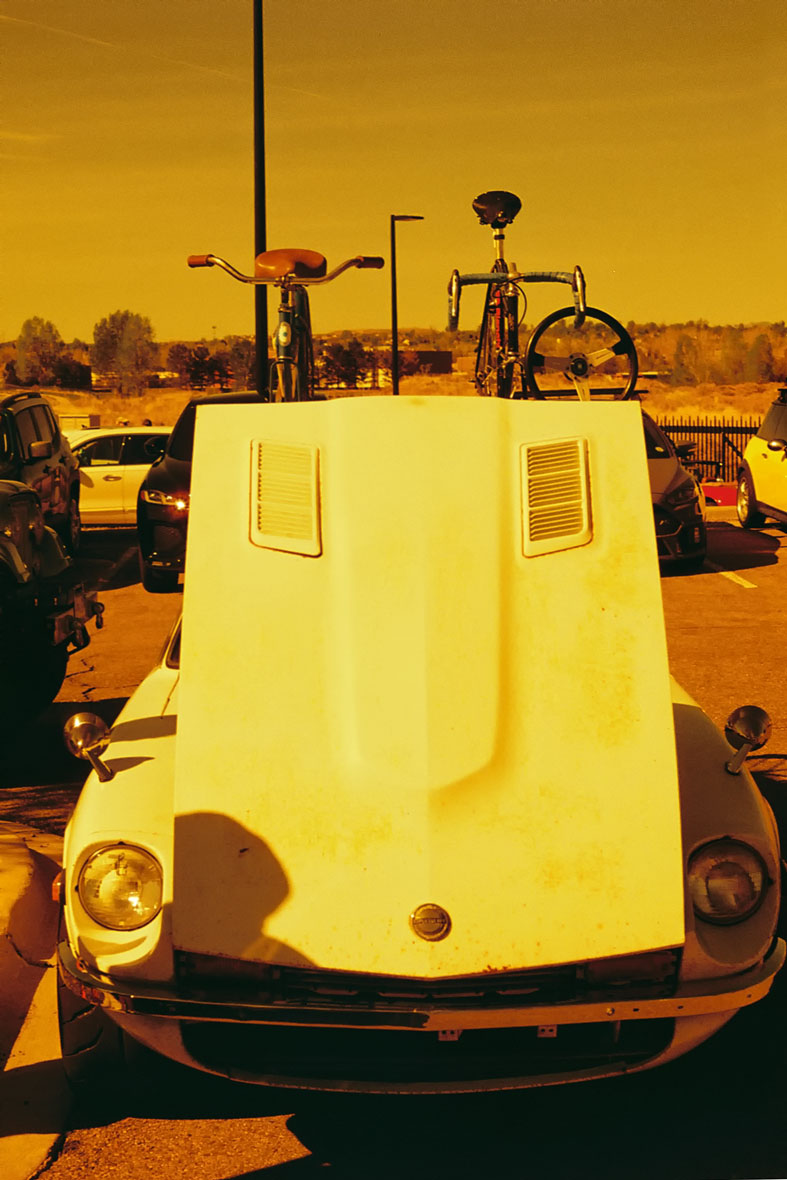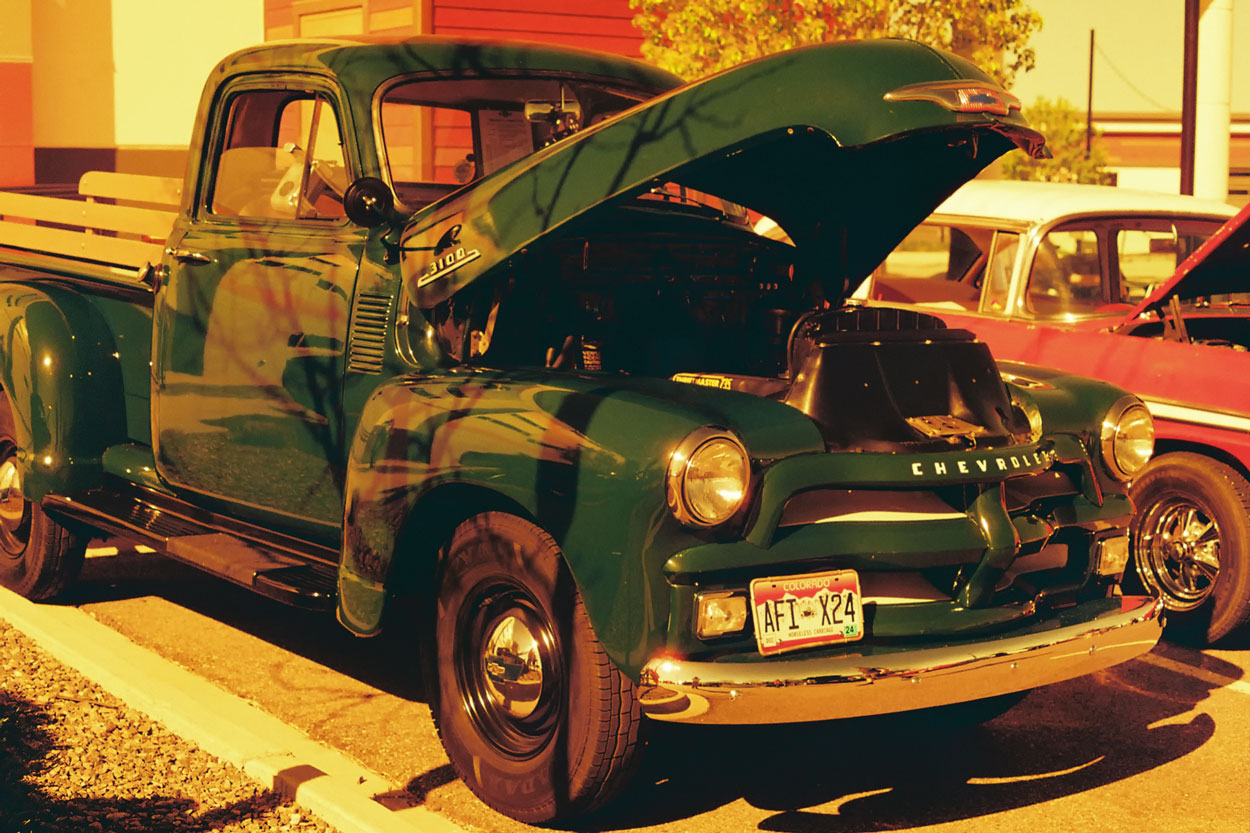For another look at my experience shooting Lomography Redscale XR 50-200 film jump over to my car photography blog to see what the “redscale” film looks like in my field test.
Today’s Post by Joe Farace
A red rose is not selfish because it wants to be a red rose. It would be horribly selfish if it wanted all the other flowers in the garden to be both red and roses.—Oscar Wilde
When ordering from Blue Moon Camera and Machine in Portland a 36-exposure roll of Lomography Redscale XR 50-200 film cost me $12.15. The XR stands for Xtended Range and Lomo says you can use any ISO setting on your camera between ISO 50-200; more on that later. I used ISO 200 for the roll that I shot in my Canon A-1 with FD 50mm f/1.8 lens at the May ’22 Cars and Coffee event at the Vehicle Vault in Parker, Colorado on Saturday May 14. The camera was shot in Tv mode, so there’s no EXIF data and no exposure data was manually recorded.
 Redscale XR is a C-41 color negative film that has been given Lomo’s “redscale” treatment that’s produced by (them) flipping the film backwards so when it’s exposed inside your camera the image-forming light from the lens hits the base layer first instead of the emulsion side of the film. This produces images that should have a red-orange color cast producing an effect that Lomo claims is “similar to placing a red filter on the lens.”
Redscale XR is a C-41 color negative film that has been given Lomo’s “redscale” treatment that’s produced by (them) flipping the film backwards so when it’s exposed inside your camera the image-forming light from the lens hits the base layer first instead of the emulsion side of the film. This produces images that should have a red-orange color cast producing an effect that Lomo claims is “similar to placing a red filter on the lens.”
After shooting at Cars & Coffee Mary and I decided to make the 30-mile round trip to Mike’s Camera in Lone Tree, Colorado to drop of the Lomo film for processing. When I shot the Agfa Ultra 50 film in my Canon AV-1, I took that film to Mike’s and they did a terrific job of processing and scanning in two days!
When I dropped of the film I decided to I not tell them this was “special” film or worry about color correcting the scans or index print because I wanted to see how they handled the film under their normal procedures. When asking when I could pick up the processed film, I was told “one week.” “Why,” I asked. “Internet problems.” Based on my last experience, I decided to call on Wednesday, May 18 and spoke to someone who told me the film was processed and he would call me back when the scans were finished. In a little more than two hours he called me back and I headed to Mike’s to pick up the film and the CD.
As before the 1024×2048 standard scans were really good. I think the next time that I send any C-41 film* to Mike’s Camera I’ll opt for the 2048×3072 scans that cost another seven bucks. In examining the negatives, however, I think that Lomography is somewhat optimistic about their suggested ISO spread of 50-100-200. At ISO 200 the negatives for some of my images were at least a half-stop underexposed. I think 100 ISO would be a better recommendation for this film or 50 if you prefer a “heavier”negative. Because of the slight underexposure there was a small but noticeable amount of grain visible in some of the images. That may bother you or not but if it does you can use software such as DFine to reduce it. I may use my technique for Correcting Underexposed Portraits on a few of the car photographs to correct for the slight underexposure. But it’s no biggie
 Lomo said the intensity of the film’s yellow/orange/red cast will vary based on how the film is rated and exposed. They suggest that more overexposure produces more intense coloration. Since the yellow/orange cast of my scans was about as intense as I could like I can’t imagine a more intense color cast when shooting at 100 but will give it a try next time, to, you know, see what happens. And if you try to eliminate the yellow/orange color cast in Photoshop, good luck. Even the redoubtable PictoColor iCorrect EditLab Pro found it challenging. Shoot the film for what it is; not what it isn’t. (That’s a white Z-car with the bikes, FYI.)
Lomo said the intensity of the film’s yellow/orange/red cast will vary based on how the film is rated and exposed. They suggest that more overexposure produces more intense coloration. Since the yellow/orange cast of my scans was about as intense as I could like I can’t imagine a more intense color cast when shooting at 100 but will give it a try next time, to, you know, see what happens. And if you try to eliminate the yellow/orange color cast in Photoshop, good luck. Even the redoubtable PictoColor iCorrect EditLab Pro found it challenging. Shoot the film for what it is; not what it isn’t. (That’s a white Z-car with the bikes, FYI.)
When shooting Lomography’s Redscale XR film I didn’t have a clue what the finished images would look like when they were processed. Now that I have a handle on the “Redscale” look, I’ll have more fun the next time I shoot with it and, I think, so will you. After all the motto of this blog is—Have Fun With Your Photography.
*Since Mike’s Lone Tree store sends their customer’s black and white film to their Boulder location for processing, it takes longer than the few days it takes for C-41 film, which is done in-house. I’ll continue to send my black and white film to The Darkroom in San Clemente because it takes about the same amount of time. They may be 1100 miles away but I only have one 5-mile drive to mail the film at the post office, where I check my PO Box anyway, and the processed film is delivered to my home. I may be wrong but I also think The Darkroom may have a better handle on processing some of the off-the-wall black and white emulsions that I send them.
Just a reminder: Podcast #3 is live now on my YouTube channel, Joe Farace’s Videos, featuring a look at the Leica Z2X and my experiences shooting 22-year old Agfa color film in a 40-year old Canon SLR, plus some information on where I get my ideas for blog posts!